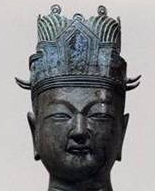Goryeo
Goryeo (918–1392) was a Korean kingdom established in 918 by King Taejo. It is where the modern name "Korea" is derived from. Goryeo succeeded the later Three Kingdoms of Korea and preceded the Joseon Dynasty. The kingdom is notable for its significant achievements in culture, technology, and trade, as well as the military conflicts with neighboring states and invasions it endured.
History[edit | edit source]
Goryeo was founded after the unification of the Later Three Kingdoms under Wang Geon, who later became known as King Taejo. The kingdom saw the zenith of Korean Buddhist culture and the creation of the Jikji, the oldest extant book printed with movable metal type in 1377, predating Gutenberg's printing press. Goryeo faced numerous invasions by the Khitan people and later by the Mongol Empire, which led to its eventual vassalage under Mongol rule before regaining independence.
Government and Society[edit | edit source]
The Goryeo dynasty was characterized by a highly centralized government and a complex system of civil service examinations, which was influenced by the contemporary Song Dynasty of China. The Goryeo military regime, which lasted from 1170 to 1270, marked a period of military rule within the kingdom. Despite the dominance of the aristocracy and military officials, Buddhism played a significant role in the state affairs and society.
Culture[edit | edit source]
Goryeo is renowned for its cultural achievements, especially in Buddhism, literature, and the arts. The production of Goryeo celadon, a type of green-glazed pottery, reached its peak during this period, known for its beauty and technical sophistication. The kingdom also contributed significantly to Korean literature, with works such as the Samguk Yusa and the Samguk Sagi, which are invaluable records of ancient Korean history and legends.
Economy and Trade[edit | edit source]
The Goryeo dynasty had an active trade network, engaging in exchanges with the Song Dynasty, the Jurchen people, and various Central Asian states. Its strategic location on the Korean peninsula facilitated maritime trade, which led to the prosperity of cities such as Kaegyong (modern-day Kaeseong), the capital of Goryeo. The kingdom was also known for its production of high-quality paper and printing technology, which were highly valued in East Asia.
Military[edit | edit source]
Goryeo's military history is marked by its defense against external invasions, notably the Khitan and Mongol invasions. The kingdom developed a notable naval force, which included the invention of the turtle ship, a type of armored warship used with great effect by Admiral Yi Sun-sin in the later Joseon Dynasty against Japanese invaders.
Legacy[edit | edit source]
The legacy of Goryeo is evident in modern Korea, from its contributions to Korean culture and technology to the continued use of the Goryeo name as the root of "Korea." The dynasty's history is a testament to the resilience and innovation of the Korean people, influencing the development of Korea's social, political, and cultural identity.
Search WikiMD
Ad.Tired of being Overweight? Try W8MD's physician weight loss program.
Semaglutide (Ozempic / Wegovy and Tirzepatide (Mounjaro / Zepbound) available.
Advertise on WikiMD
|
WikiMD's Wellness Encyclopedia |
| Let Food Be Thy Medicine Medicine Thy Food - Hippocrates |
Translate this page: - East Asian
中文,
日本,
한국어,
South Asian
हिन्दी,
தமிழ்,
తెలుగు,
Urdu,
ಕನ್ನಡ,
Southeast Asian
Indonesian,
Vietnamese,
Thai,
မြန်မာဘာသာ,
বাংলা
European
español,
Deutsch,
français,
Greek,
português do Brasil,
polski,
română,
русский,
Nederlands,
norsk,
svenska,
suomi,
Italian
Middle Eastern & African
عربى,
Turkish,
Persian,
Hebrew,
Afrikaans,
isiZulu,
Kiswahili,
Other
Bulgarian,
Hungarian,
Czech,
Swedish,
മലയാളം,
मराठी,
ਪੰਜਾਬੀ,
ગુજરાતી,
Portuguese,
Ukrainian
Medical Disclaimer: WikiMD is not a substitute for professional medical advice. The information on WikiMD is provided as an information resource only, may be incorrect, outdated or misleading, and is not to be used or relied on for any diagnostic or treatment purposes. Please consult your health care provider before making any healthcare decisions or for guidance about a specific medical condition. WikiMD expressly disclaims responsibility, and shall have no liability, for any damages, loss, injury, or liability whatsoever suffered as a result of your reliance on the information contained in this site. By visiting this site you agree to the foregoing terms and conditions, which may from time to time be changed or supplemented by WikiMD. If you do not agree to the foregoing terms and conditions, you should not enter or use this site. See full disclaimer.
Credits:Most images are courtesy of Wikimedia commons, and templates, categories Wikipedia, licensed under CC BY SA or similar.
Contributors: Prab R. Tumpati, MD






